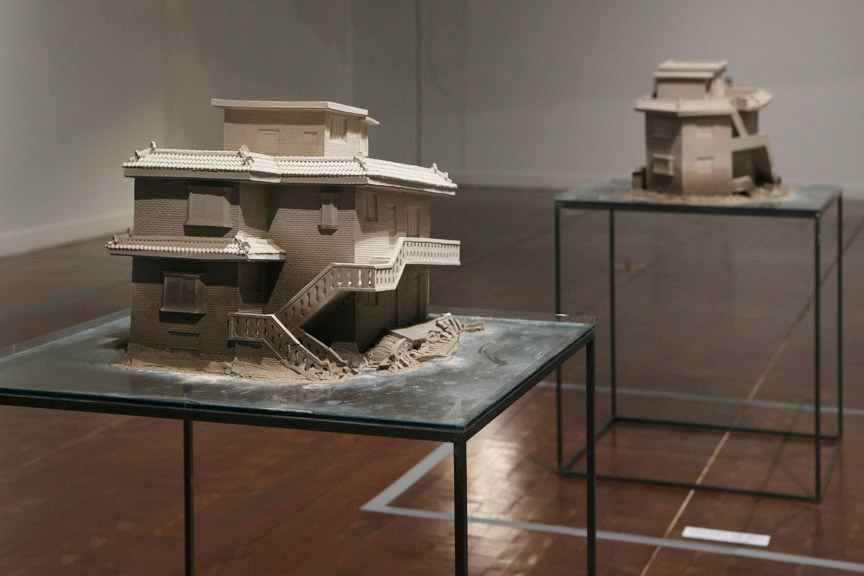Shows
“City_net Asia” at Seoul Museum of Art


Launched in 2003, “City_net Asia” is a biannual exhibition at the Seoul Museum of Art (SeMA) that addresses regional issues through contemporary art, in collaboration with three institutions from other Asian cities. For this fifth edition, SeMA invited: the 21st Century Museum of Contemporary Art in Kanazawa, Japan; the Jim Thompson Art Center in Bangkok, Thailand; and the artist-run nonprofit Ruangrupa in Jakarta, Indonesia. While this is an interesting opportunity for established art institutions and groups to collaborate their curatorial expertise on topics of shared regional concern, the resulting collection of mini-exhibitions are not always equally impressive.
This year curators from each organization were allotted a gallery in which to present an exhibition dealing with the concept of “disasters”—geological, political, social or cultural—that have recently devastated communities in the region. The Seoul section, titled “Silent Conflict,” cast light upon the psychological and social dystopia that pervades many Asian metropolises. Juree Kim’s clay sculptures of a collapsing home in Evanescent Scape (2011) reflect the disappearance of entire neighborhoods in the name of urban renewal. Young-mi Chun portrays the tension in society’s resignation to yet rising resentment of the status-quo in his video Day Dream (2001-11). Jakarta’s contribution, titled “Subsist,” addressed how society adapts to rapid urbanization, and featured artist collective Ruangrupa’s multimedia installations Cinema Wagon (2010-11) and Lonely Market (2009). “Bang-kok 2011” explored the socio-political conflict between the urban elite and rural poor in Thailand, particularly in the eight-panel oil on canvas work Lost in the City (2006) by Navin Rawanchaikul. The Kanazawa section, “Towards Recovery," was a more introspective and at times painful response, dealing with the social responsibility for major tragedies that have shaped modern Japanese history.

Considering the fact that “City_net Asia” could, in years to come, constitute a historic snapshot of contemporary artists from up to 76 different cities across the Asian continent, this is an ambitious exhibition concept. Yet, here in a single show, it seemed misleading to represent the concept of “disasters”—richly explored by the participating curators, and deeply relevant to our present—with just four Asian cities. For a continent as complex as Asia, this raises the question of which voices may have been left out. Moreover, the attempt to fit this concept into four small galleries resulted in some sections lacking focus, and stronger individual works—such as Sangwoo Kang’s pen on ceramic sculpture The Cloud of Rapture (2008) and Ary Sendy’s photographic series of partially demolished homes, Traces of Home (Jejak Rumah) (2009-11)—becoming lost in the muddle.

Amongst the various mini-exhibitions, Kanazawa’s, curated by Hiromi Kurosawa, senior curator at the 21st Century Museum of Contemporary Art, stood out. Isao Hashimoto’s media installation titled 1945-1998 (2003) graphically depicts the number nuclear explosions (including test detonations) worldwide in the last half-century. Its artificial bleeping pierced through the stillness that pervaded the gallery due to this frank tally of calculated destruction. The darkness of Chiharu Shiota’s During Sleep (2011) seemed even more threatening next to Motoi Yamamoto’s fragile salt installation, Floating Garden (2011). The small cut-out “sprouts” emerging from the front page of a newspaper dated March 11, 2011—the day of Japan’s Tohoku earthquake—in Minding My Own Business (2011) by Yuken Teruya, were a thoughtful and poetic development of his earlier, well-known Paper Bag Sculpture Series. Saburo Ota’s portraits of Hiroshima victims printed on what appears to be black-and-white postage stamps in Post War 60 Atomic Bomb Victim (2005) remind us of the real people behind such tragedies as the bombings of Hiroshima and Nagasaki. Finally Yanobe Kenji’s haunting documentary film Mythos (2010), based on his recent installation at the Nizayama Forest Art Museum, a converted former hydroelectric power station, in which he seems to transform very recent memories of disaster into a work of art by harnessing the elemental force of electricity.
While certain works in the other galleries may have represented theoretical observations, or nominal reflections on the idea of disasters that have recently affected Asia, the works in Kurosawa’s “Towards Recovery” did what art does best: visualize those things that are at times unspeakable.







